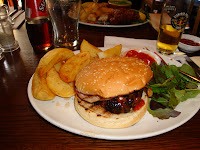


Hi YA (Liverpool Greeting)
We were up and at them early again this time to do some touring of the North Yorkshire Coast. We started out on the motorway to cut off some travel time and to get to see the most we can on our last day in the Yorkshire Area, before moving onto secondary and back roads. Once on the secondary roads we drove through some very pretty towns. It almost seemed like we were back in Ontario, as we passed through Picton, Scarborough, Pickering and stopped at the seaside town of Whitby. This was my first view of the North Sea and it was breathtaking as we came over the hill. The picture is from the town of Whitby. We then headed off to the North Yorkshire Moors.
The North York Moors (also known as the North Yorkshire Moors) is a national park. The moors are one of the largest expanses of heather moorland in the United Kingdom. It covers an area of 1,436 km² (554 square miles), and it has a population of about 25,000. The North York Moors became a National Park in 1952, through the National Parks and Access to the Countryside Act of 1949. Rugged and desolate looking in the spring but must be spectacular when the Heather is in bloom. The Yorkshire Moors were formed from sandstones, which erode slowly and form poor acid soils which are deficient in nutrients. They are less permeable to water, impeding drainage and encouraging the formation of bogs. Sphagnum moss bogs are common where there is abundant rain and poor drainage. Cotton grass is a distinctive plant which grows in the boggy areas. In the cold acid waters of peat bogs there is little decomposition of organic material with the result that the dead sphagnum moss gradually accumulates to form peat. This raises the levels of the bogs and they dry out. Heather then invades the area.
The Dales on the other hand are green upland pastures separated by dry-stone walls and grazed by sheep and cattle. The Dales themselves are 'U' and 'V' shaped valleys, which were enlarged and shaped by glaciers, mainly in the most recent, Devensian ice age.
Our last stop for the day is back in the Dales at Fountains Abbey and the Studley Royal. It is a ruined Cistercian monastery, founded in 1132. Fountains Abbey is one of the largest and best preserved Cistercian houses in England. It is a Grade I listed building and owned by the National Trust. Along with the adjacent Studley Royal Water Garden, it is a UNESCO World Heritage Site. We only walk the Abbey and a short walk about a mile around the river and lake. We spent about three hours here and took numerous pictures of the ruins as well as the grounds as we walk. We did not make it to the Studley Royal or the deer park so it is worth another visit.
We take secondary roads back to the hotel and go through some very pretty hamlets and towns.
You can Wiki the sites visited today for more detailed information on the history, both natural and historical, of where we were.
The trip back to Liverpool on Monday started out in rainy weather and our drive through the Pennines was rather scary for me. The fog was very thick and there was snow on the hills in some spots. Narrow winding roads are not my favorite, especially when you can't see a foot in front of you. We arrived in Liverpool in sunny conditions. Just shows the micro climates we can experience in relatively short distances in the UK.
I will have more pictures posted on Facebook by the end of Thursday and Fred will have pictures posted to Flickr by the weekend.
This is the end of our blog in the UK for now as we are returning to Ontario for me to sort out a visa so I can remain in the UK without hassles.
Ta Ra for now.
Sandy & Fred




